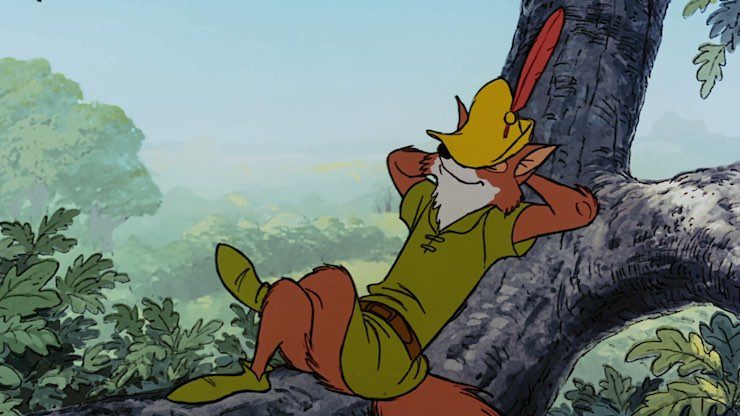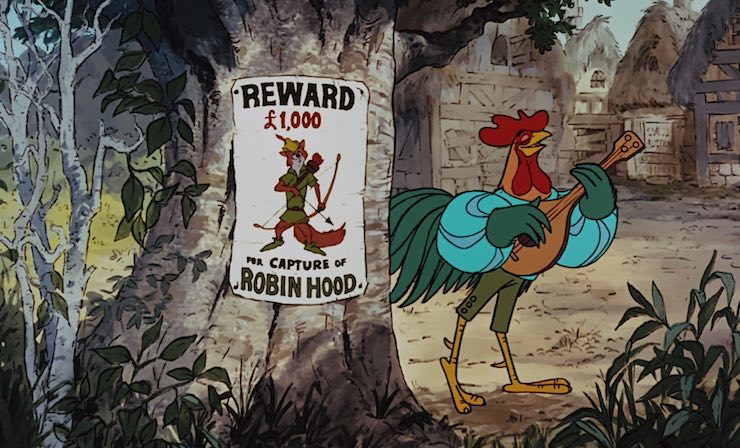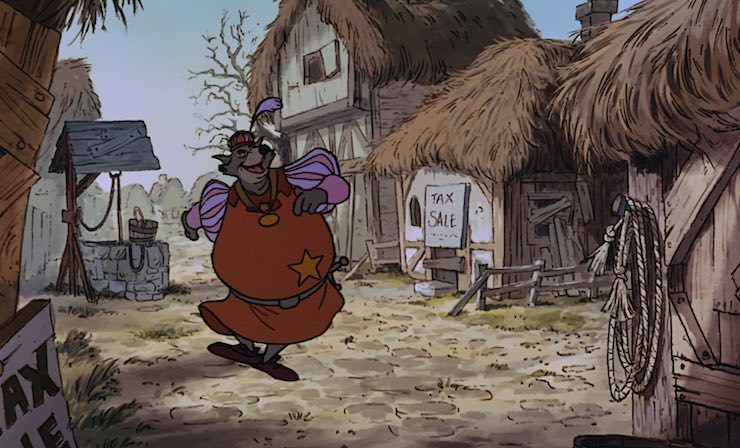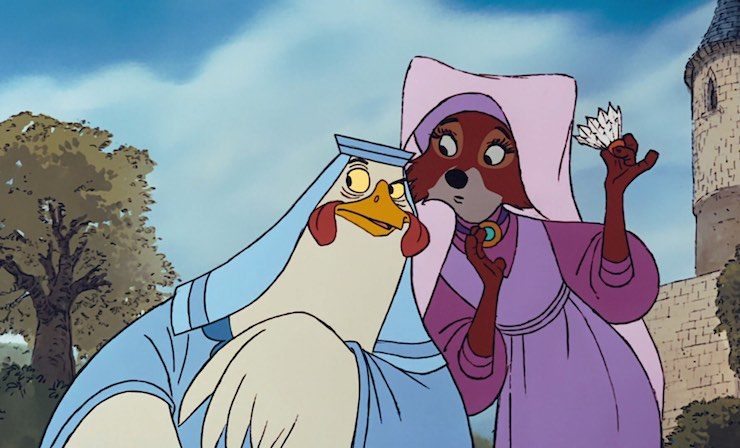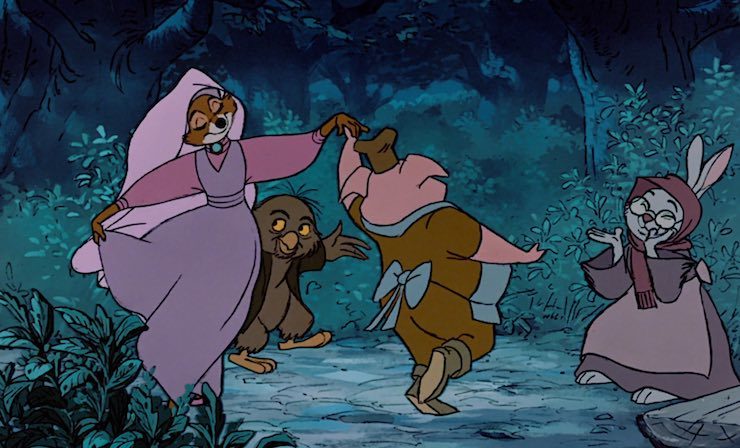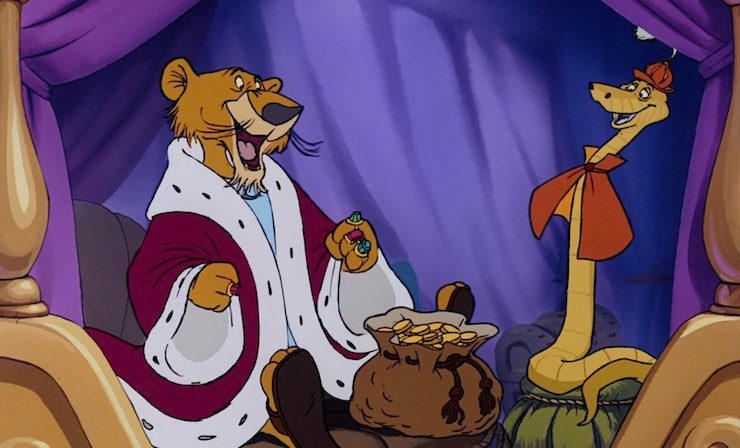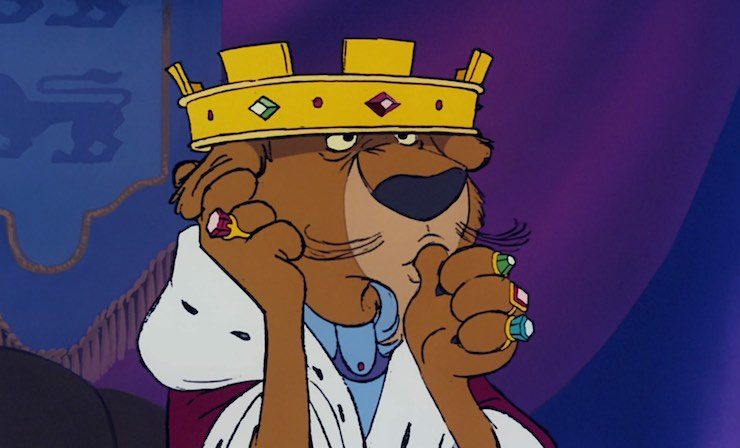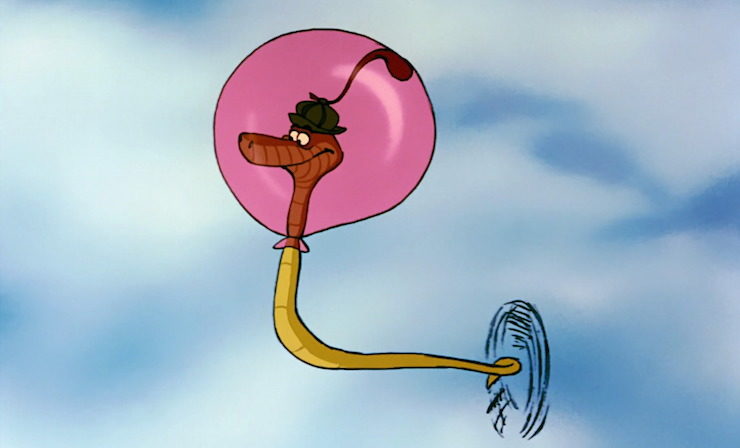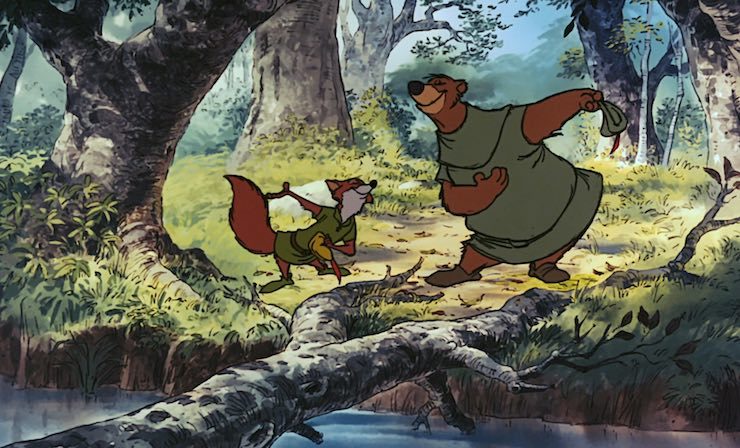Disney animators faced the 1970s in a glum mood. After Walt Disney’s death in 1966, it seemed more than possible that the storied animation department would be closed down completely as the company moved on to focus on other, more profitable things such as family friendly live action films, theme parks, and merchandise. The Aristocats had earned back its costs, but not much more than that, and critics had noted—or claimed to have noted—the lack of the distinct Walt Disney touch. The animation studio’s budget was slashed. About all the animators really had on their side was company history, which virtually identified “Disney” with “animation.” To continue the success of the Disney brand, they argued, the animation studios needed to continue to produce full length films. Disney executives were not quite persuaded, but did release just enough—just barely enough—money to let the animators cobble together another full length film, Robin Hood.
Like many Disney projects, plans for this film had been tossed around for decades, starting in the early 1930s, when Walt Disney, looking for additional projects, came across the tale of Reynard the Fox. For Disney, Reynard’s tale had a couple of advantages: it featured a cute animal, a Disney strength. As a medieval tale, it was fully in the public domain, freeing Disney from needing to pay for the copyright. It also had one major disadvantage: in the original story, Reynard is a trickster and, worse, a thief. Disney had just managed to get away with a little lying wooden puppet in Pinocchio, and a Dog With a Past in Lady and the Tramp, but an outright thief as a protagonist was a line too far. The initial financial failure of Pinocchio (1940) which had featured a fox antagonist, was also discouraging. A virulently anti-Semitic version of the story in Dutch, printed in 1941, proved the final straw.
Walt Disney still liked the idea of a fox character, however, and art director Ken Anderson—who would eventually, much to his irritation, be given script and creative credit for Robin Hood—continued to produce various sketches of animal characters and suggestions for incorporating the fox character into various other films: as cartoon segments in the live action Treasure Island (1950); as the antagonist against Chanticleer, a rooster, based very loosely on Edmond Rostand’s Chantecler, a project that was eventually dropped in the 1960s; and a Western featuring talking animals.
This is more or less how animators arrived at the incoherency that would be Robin Hood: it was a mess of all of the above ideas, none of which were, in fact, Robin Hood. Robin Hood only entered the picture (forgive the pun) when Ken Anderson realized that calling the fox Robin Hood would allow the film to keep the fox as a trickster and a thief, like Reynald, while still being—mostly—a hero, like Robin Hood. A nod to that contradiction does appear early in the film, when Little John asks Robin Hood if they are good guys or bad guys. Robin says they are good guys, and then the subject is pretty much immediately dropped for hijinks, apparently never troubling Little John’s conscience again.
The decision to use the Robin Hood name did not mean that the animators had any interest in researching the Robin Hood legends to add elements of those to their trickster fox/rooster/Western film. Instead of checking literary sources like Sir Walter Scott’s 1820 Ivanhoe or Howard Pyle’s 1883 The Merry Adventures of Robin Hood, animators instead watched Robin Hood films, chiefly the 1938 classic The Adventures of Robin Hood, featuring Errol Flynn and Olivia de Havilland. That choice had some profound effects. First, The Adventures of Robin Hood bursts with color—showing off the Technicolor process was one purpose of the film—which in turn helped create the look of the Disney film, which keeps most of its characters in similarly bright colors. Most of the Disney backgrounds were based on the locations and sets Warner Bros built for their film: a positive, since Warner Bros deliberately designed those castle sets to allow for plenty of stunt work and movement, something Disney would take advantage of in some later scenes in the film. This also meant bringing in a character new to the literary Robin Hood sources: Disney’s Lady Cluck, directly based on WB’s Bess, a character created specifically for the great Una O’Connor (probably best known on this site for Bride of Frankenstein) in the earlier film.
And since the earlier film had not made the slightest pretense towards historical accuracy—or any sort of accuracy—that helped free the Disney film from any such pretense as well, allowing Disney to do such things as, say, keep the original sketches of the Sheriff of Nottingham walking around with a badge straight from the Wild West, a holdover from the earlier concept of the talking animal Western film.
At the same time, however, The Adventures of Robin Hood had been created in part to demonstrate that Warner Bros could make something other than cheap gangster films and to sneak in a highly anti-Nazi, pro-American intervention film right past censors who had strictly forbidden Hollywood studios to produce any such thing. Neither of these were huge concerns for Disney animators, so part of the fierce energy behind the earlier film was lost in this animal adaptation, replaced by elements from the previous conceptions of the fox character.
Speaking of which, I honestly don’t have a problem with the concept of an anthropomorphic Robin Hood, but some parts of the execution are, shall we say, a bit odd, starting with, what are North American raccoons doing in medieval England, and continuing with why, exactly, is Maid Marian, a fox in all senses of that word, the niece of two lions? Was she adopted? All of the other families and couples are grouped by species, so yes, this stands out. And why doesn’t Maid Marian—still a fox—eat Lady Kluck, a hen? Or the little rabbits that end up in her castle yard? Is it possible—barely possible—that she vanishes from most of the movie not because the animators had no idea what to do with her, but because she knows she has to eat a rabbit, now, and decides to indulge in that need far away from Nottingham?
(Look, I can’t be the only person who has thought this.)
The most distracting thing about the characters, however, is probably not that they’re animals, but that although about half of them sport proper British accents, one apparently arrived straight from Alabama, one is singer Phil Harris, and the others sound like they’re straight out of a Western—because, as it turns out, all of their voice actors were straight out of a Western, known specifically for those roles. This is hardly the only instance in a film filled with anachronisms and “uh, what is going on here,” but it’s one of the more distracting.
Also mildly distracting: the decision to start the film with pictures not of animals, but of a storybook filled with human knights and kings, before zooming into a rooster, Alan-A-Dale, who informs us that animals tell the Robin Hood story very differently. That’s the last of the humans, as the rooster starts to sing—later, this song would be attached to a hamster dance, but let’s try not to get too depressed in this post—introducing the characters and their voice actors, including a few celebrities, before trying to draw out the length of the picture by including little bits of animals chasing each other that—spoiler alert!—is taken straight from later scenes in the film, and by taken straight, I mean they’re the same animation cels.
It was a budget saving stunt the film would use again and again. Baloo from The Jungle Book and Little John in this film happened to be voiced by the same actor, Phil Harris, so animators simply reused the character design—and in some frames, reused the animation cels from the earlier film. Things got worse from there. If, while watching Maid Marian lift her skirts to dance in the forest to the sound of Phil Harris’ cheerful “The Phony King of England” you are suddenly struck by the resemblance to a similar dancing moment from Snow White, this would be because it is the similar dancing moment from Snow White: the animators simply traced the earlier animation. And if, in this same scene, you find yourself asking, wait a minute, isn’t that one of the cats from The Aristocats? Yes, yes, it is—in another reuse of the actual animation cels from a previous film.
When Robin Hood didn’t simply trace from previous Disney films, or reuse animation from previous Disney films, it cannibalized its own animation sequences, frequently and obviously reusing them. The crowd reaction scenes in the archery competition sequence are arguably the worst offenders, but Robin Hood also reused sequences with the church mice, the vultures, and flying arrows. In one case, to be fair, this creates a pretty decent visual joke, but mostly it results in a lot of visual, obvious repetition. The film also has a moment where Robin and Marian give each other a long, intense stare, allowing the camera to move in closer to each unmoving face—not at all incidentally allowing the animators to skip drawing several additional cels. A later scene with Prince John and Sir Hiss pulls the same trick.
As a final dismal note, all of this animation featured thick, rough, black lines, instead of the fine colored lines that Disney had created in earlier films and would start creating again in just two more films (with The Rescuers), an unavoidable consequence of the still unrefined xerography process. It’s not completely ugly, but it helped show the budget strains.
Also showing the strains: the plot, what there isn’t of it, since instead of a plot, the film went with various loosely connected bits: Robin Hood and Little John robbing the king, then a detour to meet a little bunny who is having a very very sad birthday until Robin Hood shows up, then another detour to meet Maid Marian and Lady Cluck, then the archery tournament, with the initial parts more or less lifted, except for the balloon, from the Errol Flynn film, then another detour with Maid Marian and Robin Hood, then a sad sad moment at the Nottingham jail and church (mostly to allow the animation to slow down and use fewer cels for several frames, in yet another cost cutting technique), before the final confrontation between Robin Hood and Prince John, which is only the final confrontation because after that, King Richard shows up, and, well, that’s it.
Sorta connecting this are the characters, including the little bunny who, as it turns out, wants to be an archer, and assorted other bunnies, and a turtle, and some poor church mice, some vultures under the impression that they are in a Western film, and of course Robin Hood, Baloo—er, that is, Little John—Friar Tuck, the Sheriff of Nottingham, and, singing along, Alan-A-Dale. Most are unmemorable, with two exceptions: the villains, Prince John (voiced by Peter Ustinov) and Sir Hiss.
Prince John is often regarded as the most inept of the Disney villains, in large part because his plan to capture Robin Hood at the archery tournament fails spectacularly, because his underlings openly mock him, and because he manages to set his own castle on fire. Not exactly strong evidence for competence, I admit. Oh, and he’s more than a bit sexist, with his insistence that women can’t be bandits. Granted, in this film, women aren’t bandits—these particular women are just Robin Hood and Little John in unconvincing disguises, but still, his reasoning is not exactly great here. And even his loyal and evil underling Sir Hiss objects to one of Prince John’s plans as being too evil.
But against this, Prince John also manages to succeed in most of his goals. He amasses sacks of gold and manages to throw nearly the entire population of Nottingham into jail—and not just briefly, either. His plan for drawing Robin Hood out does, indeed, draw Robin Hood out: if the rest of his minions had been even slightly more competent—and had Lady Kluck not flown to the other side—it might even have solved his Robin Hood problem. And he comes extremely close to killing Robin Hood, more than once: indeed, in one scene the characters are briefly convinced that Robin Hood is dead. And in the end, Robin Hood never does completely defeat Prince John. That’s King Richard.
No, Prince John isn’t so much inept as pathetic. And here is where—on top of the film’s other issues—I find myself cringing more than once. Because Prince John is laughed at, again and again, by the other characters, because he still cries for his mother and sucks his thumb, despite being a grown-up. Of sorts.
I cringe, partly because I can identify, closely. It took me awhile to break that particular habit—sucking my thumb. But partly because Prince John is getting mocked for being a child—much like his audience. He ends the film doing hard labor, presumably the first step in becoming a grown-up. It’s deserved: he has, after all, spent the entire film mostly lounging around while his minions busily dispossess the good people of Nottingham of their gold, and it’s no doubt about time that he put in some actual labor.
At the same time, however, I can’t help but feel, as the film goes on, that what I’m really watching is not so much the story of Robin Hood, stealing from the rich and giving to the poor, but rather the story of a little lion with very little self-esteem and deep set parental issues, who ends up getting bullied by nearly everyone except for his one friend, and after finally getting his vengeance, ends up in jail.
What I’m saying is, I don’t necessarily know who to cheer for here. I’m back to Little John’s question at the beginning of the film: Hey, Robin, are we the good guys, or the bad guys? That question is inherently part of most Robin Hood retellings, granted, since they are stories that cheer on a thief, but I think perhaps Walt Disney was on to something when he said that having a crook as a protagonist in an animated film for kids had issues.
Robin Hood can be, and has been, read as a metaphor for what was more or less going on at Disney at the time—the benevolent, wise, rightful ruler (Walt Disney) gone, replaced by various inept villains (the incoming executives) trying to choke every last cent out of the morose survivors (the animators) and ok, fine, I can see it that way. But although this may be an accurate metaphor, it’s not always a particularly entertaining one.
On a lighter note, Robin Hood has several cute visual jokes here and there—like having the royal trumpeters be trumpeting elephants, get it, ha ha? And the moment when Sir Hiss ends up floating away in a balloon, only to be shot down later. It’s not at all period, and I’d love to know how anyone at a medieval fair managed to find latex for a balloon, but maybe they used a pig’s bladder. Or maybe they got Little John, with his distinctive American accent and general feeling that he’s just attending a modern Renaissance fair, to pick up some balloons before he wandered into the film. However, since this is soon followed by an even greater anachronism as Lady Cluck and various rhinos start tackling each other to the strains of what sounds suspiciously like American football music (mostly to allow Robin Hood to sneak in yet another repeat of the same cheering crowd sequence) I suppose I shouldn’t complain. Plus, if we get too into this, we’ll also have to figure out where Robin Hood and a later band player picked up their sunglasses.
I’m also amused by the moment when the Sheriff of Nottingham saunters into a castle, singing Little John’s none too kindly song about Prince John, and getting Sir Hiss to join in—it’s a rather catchy tune, after all, so I’ll buy this. Even if this does result in crushing taxes on the animal population. All of that ended up being rather better than I remembered.
Robin Hood did decently in its initial box office release and a few later rereleases. The company still occasionally releases Robin Hood trading pins and fine art from time to time, and Disney caricature artists will draw you as a fox character if you ask. (That may not actually be related to Robin Hood, but I thought it was important to note.) Otherwise, the film fell into obscurity, remembered, when it’s remembered at all, as either one of the weaker Disney films or the film that helped to bring us that hamster dance moment, however incidentally.
But for all its flaws, Robin Hood had two major effects on the history of animation. First, this was the film that brought Don Bluth, who would later create his own animation studio, back to Disney and trained him in character animation. And second, its box office take was enough to prevent Disney executives from shutting down the animation department—though for the next several years, Disney would focus on adaptations of literary sources instead of original films.
Next up: Fantasia 2000.
Mari Ness lives in central Florida.










